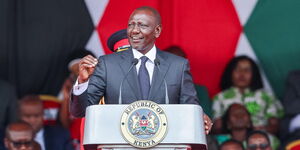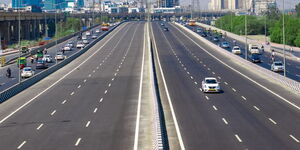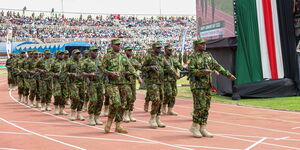There are a number of measures one can take to save on energy consumption at home, and significantly reduce one's monthly electricity bills.
Since electricity is a limited energy resource, it is vital that one learns how to use it as efficiently as possible. This also helps in saving money.
To avoid that irritating beeping sound that pops up whenever the electricity token meter is almost depleted, Kenya Power detailed 7 ways to prolong the duration of power units as detailed below.
Water Heating
The energy supplier recommends the immediate repair of any leaking pipes or taps to prevent loss of hot water.
To put it into perspective, every 30 drops per minute from a hot water tap costs you around 18 KWh per month (roughly Ksh234).
One should also reduce the amount of hot water used by not letting water run while shaving or when washing dishes.
It is estimated that if you take a 30-minute instant shower every day, you are likely to spend an average of Ksh500 per month to cover this. If your household has 3 other members doing the same, it translates to at least Ksh2,000 a month.
Notably, less water flowing shower-heads consume less energy than normal shower heads, hence helping cut your bill.
Ironing
Set one day a week for this task. Sort all the clothes into fabric types and start ironing the pile that requires the lowest temperature (the synthetics), proceeding gradually until you get to the hardest ironing fabrics (the linens).
This will not only save you time and effort but will also help in reducing electrical energy consumption.
Turn off the iron box five minutes or so before all clothes have been ironed and finish ironing with the residual heat stored in the sole plate.
Do not leave the iron box on electricity supply if you have to attend to other duties.
Always use an iron box that is thermostatically controlled.
According to Kenya Power, using a 1,000 watts iron box for 1 hour per day will use 30 KWh per month costing you about Ksh 390.
Entertainment Equipment
Most of us are guilty of leaving our appliances plugged and on even when not in use (especially the phone charger).
It is important to note that electrical appliances cannot be completely switched off without unplugging the device or turning it off at a power strip.
When this is not done, the appliances continue to draw power. This power consumption is known as 'stand-by power.'
A television left on stand-by can use up to 10% more power. However, switching off your electronics can save up to 50% of the energy it consumes.
Refrigeration
Place the fridge away from heat sources such as direct sunlight, ovens and other appliances.
Ensure there is adequate ventilation at the back, sides and top. At the very least, two inches of space all around should ensure efficient exchange of heat.
Adjust the thermostat to maintain correct temperature. The most efficient temperature for a fridge is between 3 °C and 5.5 °C. Cooler temperatures are not necessary and incorrect temperature settings cause an increase in energy consumption.
Keep the coils at the back dust-free as accumulation of dust on condenser coils can increase energy consumption by up to 30%.
Ensure the door seals are in good shape. If the door doesn’t seal well, cold air escapes and lets in warm air which the fridge uses more energy to cool. Minimize the number of times you open the fridge.
Open/close habits waste 50-120 KWh of energy a year which accounts for 10 - 24% of the total energy consumption of the fridge.
Defrost a non-frost free freezer before the frost exceeds a quarter inch in thickness. More frost makes the fridge use more energy.
Allow for foods to cool before placing them in the fridge. Cooling hot food in the fridge uses more energy.
Cover liquids and food stored in the fridge. Uncovered foods release moisture and in turn get dried out. This process makes the compressor work further.
Cooking
Use pots and pans with flat bottoms to enhance effective heat transfer since they will be heated uniformly.
Preheat the oven only when necessary and only for the required time.
Use the oven to capacity by cooking more than one dish or one meal at a time.
Do not open the oven door unnecessarily; every time you open the oven door to check cooking, you lose 20% of the heat. (Oven temperature drops 25-30oC every time you open the oven door.)
Use an electric kettle to boil water instead of the cooker.
Lighting
Use LEDs which last longer than the ordinary incandescent lamps. LEDs also generate less heat which means less cooling bills. All in all, LEDs can save up to 80% of the energy used on lighting.
Enhance the use of timers to turn security lights on in the evening and off in the morning to ensure the lights are switched on only when necessary.
Additionally, you can utilise photo sensors for security lighting to automatically turn your light on at night and off during the day.
Turn off lights when you are not using them, even just for a few minutes. You save electricity every time you turn lights off, no matter how short the duration.
Separate the lighting circuit to ensure that only the required lighting is switched on.
Design houses that maximize on natural sunlight during the day.
Laundry / Dishwashing
95% of the energy used by a washing machine goes into heating the water.
One could save a lot by just lowering the temperature of the water. Reducing this from 60 to 40 degrees can save up to 110 KWh per year.
A typical washing machine uses 5.24 KWh of electricity per wash load and costs about Ksh 68 per wash (when washing with hot water). Making 20 loads of washing per month will cost approximately Ksh1,360.
On the other hand, washing with cold water uses 0.26 KWh per load and costs only about Ksh3.38.
When making a purchase, opt for an energy efficient washing machine.
Choose a front loading model which uses 63% less water on average. Less water costs less to heat. In addition, always, ensure that the laundry machine is fully loaded in each cycle.
Practicing these tips will ensure the exercise of paying the electricity bill or purchasing tokens isn't as painful.












